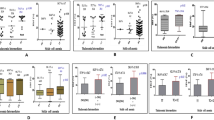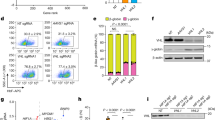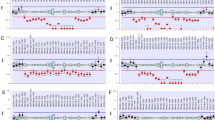Abstract
Blood from seven newborns, a 13-y-old, and seven adult family members with a suspected hemoglobinopathy because of unexplained cyanosis was obtained for analysis to determine Hb oxygen affinity and to characterize and quantify the Hb variants. Their oxygen saturation was 76 to 84%. The P50 was 30.3 ± 2.9 for the newborns and 32.5 ± 2.6 mm Hg for their related adults. In the same order, the plasma erythropoietin was 7.4 ± 2.9 and 15.9 ± 3.7 mU/mL, whereas 2,3-diphosphoglycerate was 16.1. ± 2.9 and 15.9 ± 3.7 μmol/g Hb. In four of the newborns with increased P50, the mother had a normal P50 (27 mm Hg), which indicated a greater maternal oxygen affinity than the fetus with no adverse effects on the fetus. Genetic analysis of α-globin genes demonstrated a heterozygous mutation on the α2 gene [α94(G1)Asp→His] for each of the newborns and their related adults. The same mutation was found on the α1 gene in an adolescent and her father. The mRNA measurements showed that the α2- to α1-globin mRNA mean ratio was 2.5, α2 mutant globin mRNA/total α2-globin mRNA was 45.0%, whereas the α1 mutant globin mRNA/total α1-globin mRNA was 37.8%. The level of α2 mutant globin/total α-globin was 27.3 ± 1%, and α1 mutant globin/total α-globin was 23.8 ± 1%. The percentage of synthesized α2 and α1 mutant globins was 27.5 ± 2 and 26.1 ± 1, respectively. The ratio of the α2/α1 mutant globins was 1.1, which corresponded to a ratio at the mRNA level of α2/α1 of 2.5 ± 0.5, which suggested that there is a less efficient translation of the α2 mRNA than α1 mRNA. The reversal of the physiologic fetomaternal oxygen affinity had no effects on fetal development.
Similar content being viewed by others
Log in or create a free account to read this content
Gain free access to this article, as well as selected content from this journal and more on nature.com
or
Abbreviations
- ODC:
-
Hb-oxygen dissociation curve
- DPG:
-
2,3-diphosphoglycerate
- P50:
-
Po2 required to achieve a saturation of 50% at pH 7.4 and 37°C
References
Shroeder WA, Shelton JB, Shelton JR, Powars D 1979 Hemoglobin Sunshine Seth - α2 (94(G1)Asp→His) β2 . Hemoglobin 3: 145–159
Liebhaber SA, Wain Kan Y 1982 Different rates of mRNA translation balance the expression of the two human α-globin loci. J Biol Chem 257: 11852–11855
Molchanova TP, Pobedimskaya DD, Huisman THJ 1994 The differences in quantities of α2- and α1-globin gene variant in heterozygotes. Br J Haematol 88: 300–306
Liebhaber SA, Cash FE, Ballas SK 1986 Human α-globin gene expression. The dominant role of the α2-locus in mRNA and protein synthesis. J Biol Chem 261: 15327–15333
Guarnone R, Centenara E, Barosi G 1995 Performance characteristics of Hemox-Analyzer for assessment of the hemoglobin dissociation curve. Haematologica 80: 426–430
Bard H, Widness JA, Ziegler EE, Gagnon C, Peri KG 1995 The proportions of Gγ- and Aγ-globins in the fetal hemoglobin synthesized in preterm and term infants. Pediatr Res 37: 361–364
Georgieff MK, Landon MB, Hedlund B, Faasen AE, Mills MM, Hedlund BE, Faasen AF, Schmidt RL, Ophouen JJ, Widness JA 1990 Abnormal iron distribution in infants of diabetic mothers: spectrum and maternal antecedents. J Pediatr 117: 455–461
Keitt AS 1971 Reduced nicotinamide adenine dinucleotide-linked analysis of 2,3-diphosphoglyceric acid: spectrophotometric and fluorometric procedures. J Lab Clin Med 77: 470–475
Peri K, Gagnon C, Bard H 1998 Quantitative correlation between globin mRNAs and synthesis of fetal and adult hemoglobins during hemoglobin switchover in the perinatal period. Pediatr Res 43: 504–508
Dimovski AJ, Efremov DG, Gu L-H, Huisman THJ 1994 The relative levels of βA and βS mRNAs in Hb S heterozygotes and in patients with HbS-β+-thalassaemia or HbS-β+-HPFH combinations. Br J Haematol 87: 353–356
Cotes PM, Spivak JL 1991 Erythropoietin in health and disease. In: Erslev AJ, Adamson JW, Eschbach JW, Winearls CG(eds) Erythropoietin. The Johns Hopkins University Press, Baltimore, 184–207.
Bard H, Teasdale F 1979 Red cell oxygen affinity, hemoglobin type, 2,3-diphosphoglycerate, and pH as a function of fetal development. Pediatrics 64: 483–487
Bureau MA, Shapcott D, Berthiaume Y, Monette J, Blouin D, Blanchard P, Begin R 1983 Maternal cigarette smoking and fetal oxygen transport: a study of P50, 2,3-diphosphoglycerate, total hemoglobin, hematocrit, and total F hemoglobin in fetal blood. Pediatrics 72: 22–26
Bard H 1975 The postnatal decline of hemoglobin F synthesis in normal full-term infants. J Clin Invest 55: 395–398
Metcalfe J, Bartels H, Moll W 1967 Gas exchange in the pregnant uterus. Physiol Rev 47: 782–838
Novy MJ, Parer JT 1969 Absence of high blood oxygen affinity in the fetal cat. Respir Physiol 6: 144–150
Charache S, Catalano P, Burns S, Jones RT, Koler RD, Rutstein R, Williams RR 1985 Pregnancy in carriers of high-affinity hemoglobins. Blood 65: 713–718
Bunn HF 1994 Sickle hemoglobin and other hemoglobin mutants. In: Stamatoyannopoulos G, Nienhuis AW, Majerus PW, Varmus H(eds) The Molecular Basis of Blood Diseases. WB Saunders, Philadelphia, 207–256.
Author information
Authors and Affiliations
Additional information
Supported by Grant #MT-11552 from the Medical Research Council of Canada.
Rights and permissions
About this article
Cite this article
Bard, H., Peri, K. & Gagnon, C. The Biologic Implications of a Rare Hemoglobin Mutant That Decreases Oxygen Affinity. Pediatr Res 49, 69–73 (2001). https://doi.org/10.1203/00006450-200101000-00016
Received:
Accepted:
Issue date:
DOI: https://doi.org/10.1203/00006450-200101000-00016



